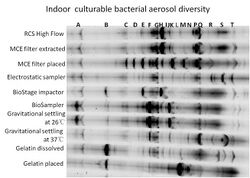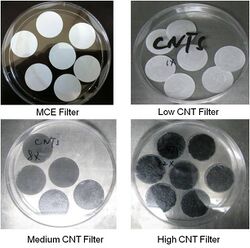Yao-Lab:Research
Home Lab Members Research Publications Patents Openings Teaching Contact News Group Gallery
Research Directions
1.Fundamental bioaerosol sampling, characterization, control, and generation
Below are some of our studies in this area:

Automated Electrostatic Sampler The integration of the AES sampler developed here with a biosensor device could offer a promising platform for the automated bioaerosol sensing.

This study presented a first demonstration that a high volume portable sampler, i.e., the RCS High Flow, can be adapted for use in PCR-based molecular detection through use of the mineral-oil-strips. The developed technique not only could yield higher culturable bioaerosol concentrations in practical environments, but also provide bioaerosol samples for rapid qPCR analysis without the filter sample extraction steps.

The results obtained here suggested that the biological collection efficiencies and culturable bioaerosol diversity obtained vary with the sampler design, sampling environments, and culturing methods.
2.Biological exposure assessment and control

In response to the disaster, we have demonstrated a viable protocol in monitoring possible infectious diseases outbreaks, while
translating bench-science into practice.

The results here demonstrated great promise of the SWNT hybrid filter in controlling biological aerosols, and suggested its potential to impact current air conditioning system. This study demonstrated a novel bioaerosol removal technique, and further tests with other airborne biological materials could lead to improved medical masks and indoor air pollution control technologies. (Xu and Yao, 2011, JAS; Guan and Yao, JAS, 2010).
3.Environmental bioaerosol detection and quantification

This study presents a first investigation of using electrostatic precipitation to quantify airborne allergen and toxin concentrations. The developed sampling protocols can be extended to other airborne allergens and toxins beyond those studied in this research.
4.Development of environmental biosensor


5.Role of bioaerosol in climate change


